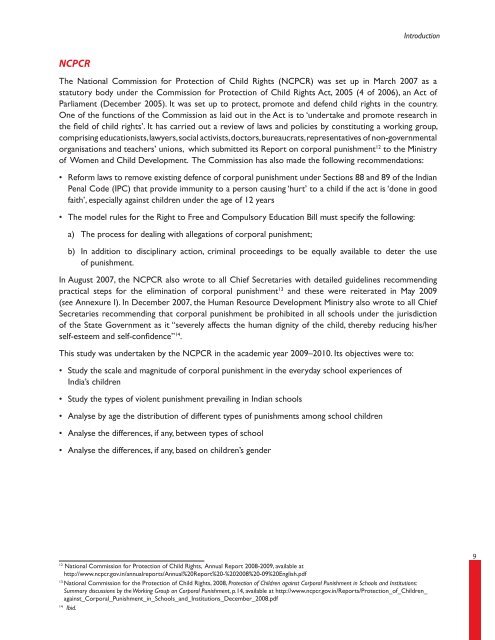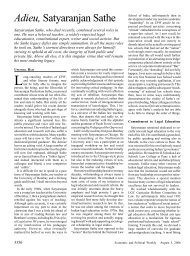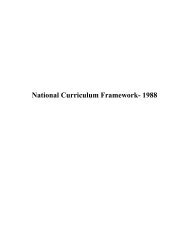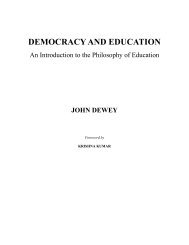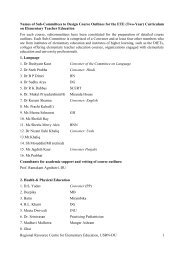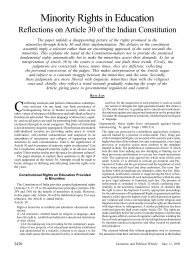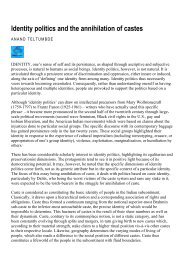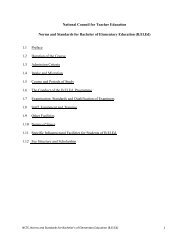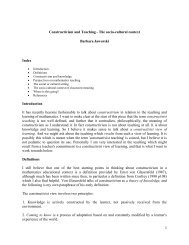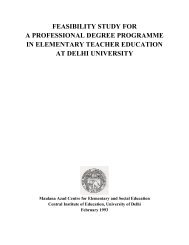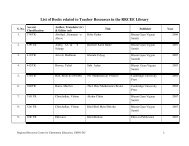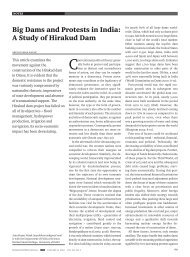Eliminating <strong>Corporal</strong> <strong>Punishment</strong> in SchoolsIt is important to note, however, that the interpretation of this Section has not been tested in the highercourts yet 11 , though India’s international human rights obligations as well as domestic policy guidancewould point towards expansive interpretation of Section 23. It is also important to note that Section 23is punishable with a maximum of six months’ imprisonment. Clearly, when a child is seriously harmed as aresult of corporal punishment, the appropriate provisions of the IPC dealing with such harm would needto be used. In addition, judgments by a few High Courts ban corporal punishment in schools, or questionlong-standing justifications for corporal punishment.However, Sections 88 and 89 of the Indian Penal Code provide immunity to a person inflicting corporalpunishment on a child if such punishment is inflicted “in good faith for the child’s benefit”. While Section 88exempts from punishment any act that is not intended to cause death, as long as it is done in good faith forsomeone’s benefit and the “beneficiary” has consented explicitly or implicitly to the act, Section 89 is theequivalent of Section 88 for a child under 12 or a person who is mentally disabled. It renders immune anadult who is the guardian of a child under 12, or acts with the express or implied consent of the guardian,or has lawful charge of a child, who inflicts harm short of intentional or reckless murder, attempted murderor grievous injury on a child under 12 “in good faith for the child’s benefit”.Clearly, Sections 88 and 89 are incompatible with the Constitutional rights to life, equality before the law,and education. They are also incompatible with India’s obligations under the Child Rights Convention, whichprotects children from torture and cruel, inhuman and degrading treatment. It is also worth emphasisingthat freedom from torture is an absolute right that cannot be qualified, as some rights, such as freedomof expression, can be. In light of the above, Section 88 needs to be amended and Section 89 needs tobe repealed as a necessary step towards protecting children from violence outside the home. Whilethese provisions remain in force, they will undermine other legal provisions that may penalise corporalpunishment.<strong>Corporal</strong> punishment and other cruel or degrading forms of punishment of children can take place inmany settings, including within the home and family, in all forms of alternative care, schools and othereducational institutions, in situations of child labour, in the community and justice systems, as a sentence ofthe courts and as a punishment within penal institutions. Table A summarises the extent to which corporalpunishment is legally regulated in India.HomeNot prohibitedTable A: Extent to which corporal punishment is legally regulated in IndiaEducation (preprimaryto highereducation)Prohibited(6-14 years; Right ofChildren to Free andCompulsoryEducation Bill, 2008)Judicial punishment Children’s homes Day-care/child-mindinginstitutionsProhibited(JJ Act, 2000)Prohibited(JJ Act, 2000)Not prohibitedSo, the juvenile justice regime does not allow corporal punishment as punishment for an offence or as adisciplinary measure within children’s homes, and Parliament has legislated against corporal punishment inschools without actually referring specifically to corporal punishment. But in no other context is corporalpunishment categorically banned.811Two appeals indicate that S. 23 has been used to prosecute allegations of sexual abuse in children’s homes or in police custody, but NOTcorporal punishment inflicted in the name of discipline. (Allan John Waters and Duncan Alexander Grant v. State of Maharashtra and MaharukhAdenwala, Crl. A. Nos. 476, 603 and 681 of 2006, decided by the Bombay HC on 23 July 2008; State v. Rameez & Others, Crl. M.C. No. 12/2006,decided by the Delhi HC on 6 April 2009).
IntroductionNCPCRThe National Commission for Protection of Child Rights (NCPCR) was set up in March 2007 as astatutory body under the Commission for Protection of Child Rights Act, 2005 (4 of 2006), an Act ofParliament (December 2005). It was set up to protect, promote and defend child rights in the country.One of the functions of the Commission as laid out in the Act is to ‘undertake and promote research inthe field of child rights’. It has carried out a review of laws and policies by constituting a working group,comprising educationists, lawyers, social activists, doctors, bureaucrats, representatives of non-governmentalorganisations and teachers’ unions, which submitted its Report on corporal punishment 12 to the Ministryof Women and Child Development. The Commission has also made the following recommendations:• Reform laws to remove existing defence of corporal punishment under Sections 88 and 89 of the IndianPenal Code (IPC) that provide immunity to a person causing ‘hurt’ to a child if the act is ‘done in goodfaith’, especially against children under the age of 12 years• The model rules for the Right to Free and Compulsory Education Bill must specify the following:a) The process for dealing with allegations of corporal punishment;b) In addition to disciplinary action, criminal proceedings to be equally available to deter the useof punishment.In August 2007, the NCPCR also wrote to all Chief Secretaries with detailed guidelines recommendingpractical steps for the elimination of corporal punishment 13 and these were reiterated in May 2009(see Annexure I). In December 2007, the Human Resource Development Ministry also wrote to all ChiefSecretaries recommending that corporal punishment be prohibited in all schools under the jurisdictionof the State Government as it “severely affects the human dignity of the child, thereby reducing his/herself-esteem and self-confidence” 14 .This study was undertaken by the NCPCR in the academic year 2009–2010. Its objectives were to:• Study the scale and magnitude of corporal punishment in the everyday school experiences ofIndia’s children• Study the types of violent punishment prevailing in Indian schools• Analyse by age the distribution of different types of punishments among school children• Analyse the differences, if any, between types of school• Analyse the differences, if any, based on children’s gender12National Commission for Protection of Child Rights, Annual Report 2008-2009, available athttp://www.ncpcr.gov.in/annualreports/Annual%20Report%20-%202008%20-09%20English.pdf13National Commission for the Protection of Child Rights, 2008, Protection of Children against <strong>Corporal</strong> <strong>Punishment</strong> in Schools and Institutions:Summary discussions by the Working Group on <strong>Corporal</strong> <strong>Punishment</strong>, p.14, available at http://www.ncpcr.gov.in/Reports/Protection_of_Children_against_<strong>Corporal</strong>_<strong>Punishment</strong>_in_Schools_and_Institutions_December_2008.pdf14Ibid.9


